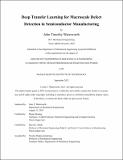Deep Transfer Learning for Macroscale Defect Detection in Semiconductor Manufacturing
Author(s)
Waterworth, John Timothy
DownloadThesis PDF (35.02Mb)
Advisor
Boning, Duane
Hardt, David E.
Terms of use
Metadata
Show full item recordAbstract
This thesis proposes improvements to wafer macro inspection processes and tools on four axes at Texas Instruments. The major axis of improvement involves real-time machine learning recommendations regarding the presence of macroscale defects. In this work, a model for detecting central defects is described in detail, and a novel approach to overcoming data scarcity through the creation of synthetic data is deployed. The binary classifier model achieves an out-of-distribution area under curve (AUC) of 0.909 for detecting hotspot defects. Detection for other classes of central defects is also explored but limited by even greater data sparsity. Models for catching spin on glass defects and edge defects are also trained with out-of-distribution AUCs reaching 0.927 and 0.906 respectively. Other axes of improvement covered in this thesis involve gauge reliability and repeatability analysis of macro inspection tools, the creation of a new user interface called OwlView, and the trial of a new macro inspection system used in-line on photolithography tools for greater efficiency. Gauge repeatability and reliability analysis gives insight into tool function and assists the team and technicians in root cause analysis. Several hardware failures of current toolsets are identified and addressed. Maintenance procedures are also updated to keep tools operating within specifications. The OwlView interface is developed with features to increase user efficiency. Additionally, the interface helps create an infrastructure for tagging more data, which will be fed back into the models to address data scarcity. Lastly, an in-line inspection trial shows achievable high quality wafer images compatible with the machine learning and inspection infrastructures developed in this work.
Date issued
2023-09Department
Massachusetts Institute of Technology. Department of Mechanical EngineeringPublisher
Massachusetts Institute of Technology